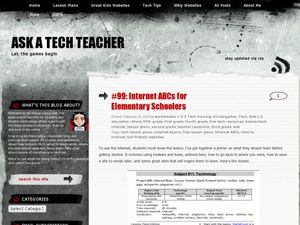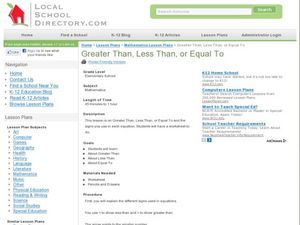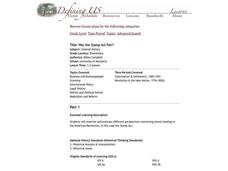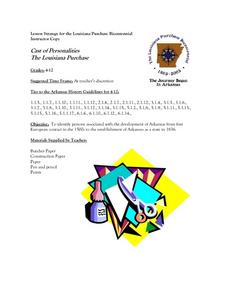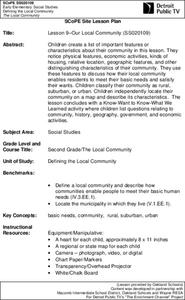Curated OER
Internet ABC's for Elementary Schoolers
Students develop basic Internet skills. In this lesson introducing the basics of the Internet, students discover how to use toolbars, address bars, how to save a website to revisit later, and how to use the back and forward buttons. This...
Benjamin Banneker Association
Celebrate Benjamin Banneker
Inventor, astronomer, surveyor, mathematician, clock maker. Learners celebrate the life of Benjamin Banneker by building creative analog clocks, making scale models, and solving problems related to surveying. The activities model the...
Channel Islands Film
Arlington Springs Man: Lesson Plan 3
Imagine being part of a team of scientists that discover the oldest human remains in North America. Imagine being part of the crew that documents this discovery. Class members get a change to be part of such an exciting adventure in a...
Curated OER
Greater Than, Less Than, or Equal To
This resource offers a quick instructional activity in using the symbols for greater than, less than, and equal to to compare single-digit numbers. However, the practice worksheet included has learners comparing numbers to the 100,000s,...
Curated OER
Apple Estimation: Percentages & Subjective Reasoning
Students practice using their estimation skills by utilizing apples. In this percentage lesson, students utilize a scale and an apple to discover the percentage of each bite they take. Students share their data with the rest...
Curated OER
Lesson Plan 3: Order of Operation
Order of operations is foundational for the future study of algebra. With ample time for instruction and independent practice these activities will help your class improve their understanding of this important concept. Includes the...
Curated OER
Truly Amazing Mammals
Explore the world of amazing mammals with your kids with special needs. Each child identifies one mammal from a previous lesson and writes a short paragraph on that mammal. This lesson states that it is intended for all levels, but not...
Math Worksheets Land
Add and Subtract Multi-Digit Whole Numbers
Help young mathematicians see the value in addition and subtraction. Offering one addition and one subtraction problem, this instructional activity walks students step-by-step through the solutions of each, starting in the ones place and...
Curated OER
Picture This
Elementary writers practice writing descriptive paragraphs by adding adjectives and sensory words to their writing. They use a picture of a monster for their descriptive paragraph. This 12-page lesson should increase your charges...
Student Puzzles
Primary Long Division
Dividing large numbers can be a long and frustrating process for young mathematicians, but after completing these skills practice worksheets they'll be masters of long division.
Curated OER
Greater Than, Less Than, or Equal To
Elementary schoolers explore using the symbols for greater than, less than, and equal to in various equations. They discuss the different signs used in equations and what each sign represents. Students practice using the various signs.
Curated OER
Social Studies: Looking at Regions
Quiz your 3rd graders on why we have regions. This regions quiz includes 16 questions on why and how we group areas into regions based on physical features, culture, politics or religion. A class discussion on technology completes this...
Curated OER
Puzzle Trees
Elementary artists use a collage and multi-media technique to create textured trees. They study the fall trees, discussing texture and what bare trees look like. They then use a variety of materials to create a textural piece.
Curated OER
Learning About Contractions
Students identify contractions. In this phonics activity, students define what a contraction is and give examples on the board. Students complete a worksheet as a follow-up.
Grammar Net
Numbers 1-30
Jot down some figures with an activity about printing numbers. First, learners fill in the blanks with the numbers next to their printed forms. Then, they complete simple addition and subtraction problems with numbers that are...
Curated OER
Was the Stamp Act Fair?
Elementary and middle schoolers examine and evaluate different perspectives concerning events leading to the American Revolution. In this case, they hone in on the Stamp Act. They research controversial bills, laws, or events of the time...
Curated OER
Cast of Personalities - The Louisiana Purchase
The origins of the state of Arkansas are the focus of this history lesson. Elementary schoolers to high schoolers identify persons associated with the development of the state from the very first European contact to statehood in 1836....
Kuta Software
Identifying Solid Figures
Reinforce basic geometry skills in an elementary math lesson. A simple worksheet prompts learners to identify and label 3-D shapes.
Institute of Electrical and Electronics Engineers
Binary Basics
Back to the (binary) basics. The resource provides a simple overview of binary code and gives two different activities to introduce it to elementary and middle school learners. Classmates write and decode messages to each other in binary...
Curated OER
Different Strokes For Different Folktales
Young readers use graphic organizers, such as Venn diagrams and story maps, to analyze a variety of folktales and the elements of a story. They use writing, sequencing activities, and creative art to identify the morals learned from a...
Curated OER
Lesson 9-Our Local Community
Second graders brainstorm and create a list of important features/characteristics that they would want to include in a community setting. They include physical features, economic activities, kinds of housing, etc. This lesson plan is a...
Curated OER
Lesson Exchange: Kite Construction (Elementary, Science)
Students learn the technology of kite making and how to make a kite and fly a kite.
Curated OER
guided reading lesson using BATS
Students answer questions, then after reading several bat books, students revisit the questions.
Curated OER
Opposites Attract (Elementary School)
Second graders generate a list of opposites found in the book, "Kaleidoscope of Kids". They use newspaper and magazine pictures to find opposites.
